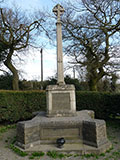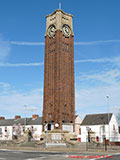Sergeant Eric Scott Morgan, 240224
- Batt - 1/6
- Unit - Nottinghamshire & Derbyshire Regiment (Sherwood Foresters)
- Section -
- Date of Birth - 1894
- Died - 23/04/1917
- Age - 22
Add to this record?
If you have photographs, documents or information that can contribute to this record, you can upload here
ContributeSource: Michael Doyle Their Name Liveth For Evermore: The Great War Roll of Honour for Leicestershire and Rutland. He was the son of John Jones Morgan, a certificated schoolmaster, born in the April quarter of 1853 in Stottesdon, Shropshire and baptised on the 5th June 1853 in St. Mary’s Church, Stottesdon (son of John Morgan and Marianne Parton) and his wife Mary Ann Morgan (nee Scott, married on the 21st May 1888 in the Church of SS. Peter & Paul, Ormskirk, Lancashire), born in the January quarter of 1854 in Aylesbury, Buckinghamshire (daughter of Robert Scott, 1813 and Sophia Lyne, 1819-1881). Erick (Eric) Scott was born in the July quarter of 1894 in Monyash, Bakewell, Derbyshire, he had one sibling, John Robert Douglas, born in the July quarter of 1891 in Monyash and baptised on the 4th October 1891 in Monyash, in March 1901 the family home was at Monyash, Bakewell.
In April 1911 Eric was employed in general farm work and was residing in the family home at The Homestead, Monyash, Bakewell, together with his father, a farmer and milk salesman, his mother and brother John, a general farm worker.
FAMILY NOTES: Eric was officially registered at birth with the Christian name spelling of Erick, however no other documents record his use of this spelling and the assumption is that it was registered incorrectly.
Eric cannot be traced to residing at any address in Coalville, even though he must clearly have both lived, and worked in the locality, and the fact that his name is recorded on three of the memorials in the town is an indication of his strong connection to Coalville.
Eric’s army service enlistment documents do not survive, therefore the currently available information pertaining to his military service has been obtained from the following sources: - 1921 HMSO Publication, Soldiers Died in the Great War, 1914 - 1919, WW1 Service Medal and Award Rolls, Army Registers of Soldiers’ Effects, WW1 Medal Rolls Index Cards, WW1 Pension Ledgers and Index Cards and the Commonwealth War Graves Commission Registers.
Enlisted/Attested in Bakewell, Derbyshire into the Territorial Force. Date not known.
Joined. At place and date not known.
Posted. To Nottinghamshire & Derbyshire Regt. Pte. Date not known.
Allotted the Regimental Service number 1706.
Posted. To 1/6th Bn. Nottinghamshire & De4rbyshire Regt. Pte. Date not known.
First entered the theatre of war in France. 26/2/15.
Promoted. To Lance Corporal. Date not known.
Promoted. To Corporal. Date not known.
Promoted. To Sergeant. Date not known.
Under the Army Council Instruction (A.C.I. 2414/1916), published on the 23rd December 1916, that promulgated a new numbering system for all Territorial Force units, Eric was allotted the regimental service number 240224.
Killed in action. In the Field. 23/4/17.
Body not recovered. Commemorated on the Arras Memorial, Pas de Calais, France.
Awarded the 1914-15 Star, British War Medal and Victory Medal.
In the event of his death, Eric nominated his mother, Mary Ann and his brother John Robert Douglas as his legatees.
The War Diary records: 23 Apr-17 – LIEVIN. The Battalion attacked FOSSE 3 DE LIEVIN. See report attached. Appendix IV and Appendix V.
Casualties in this action: -
Officers.
Wounded and Missing. Lieutenant C. A. BROWN.
Wounded. Captain E. B. JOHNSON. 2nd Lieutenant V. H. ARMITAGE. 2nd Lieutenant B. N. PARKER. 2nd Lieutenant W. ARCHER. 2nd Lieutenant K. H. BOND (At duty).
Other Ranks.
Killed 21. Wounded 71 (5 At duty). Missing 3.
APPENDIX V
Report by Officer Commanding 1/6th Sherwood Foresters on the attack on FOSSE DE LIEVIN on 23rd April 1917.
[1] The attacking force consisted of L “C” Company 6th Sherwood Foresters (Captain E. B. JOHNSON) with L “D” Company (Captain H. H. JACKSON) in support.
[2] The attacking force and its supporting Companies were distributed as follows: -
L “C” Company as per sketch map A.
L “D” Company Headquarters at M.30.a.1.5.
13 Platoon in cellars on either side of Company Headquarters.
15 Platoon at M.30.a.28.57.
14 and ½ of 16 Platoons in cellars at M.30.a.40.65.
½ 16 Platoon at corner house M.30.a.52.75.
L “A” Company were close up in reserve as per sketch A (map not sent).
[3] The objectives of the various platoons were as under: -
“C” Company.
9 Platoon. Establish posts on line M.30.c.90.18 to M.30.d.90.40 moving ALMANAC TRENCH.
10 Platoon. Make good main group of buildings on FOSSE, moving by South side of 2nd BIG ROW S.
11 Platoon. Make good ALMANAC TRENCH from M.30.c.90.18 to M.30.b.50.50.
12 Platoon. Buildings on FOSSE about M.30.b.20.10 and thence to clear trench M.30.d.35.85 to 20.40 on Howitzers ceasing fire.
“D” Company.
13 Platoon. Make good East end of 1st BIG ROW S.
15 Platoon. Make good East end of 1st and 2nd SMALL ROWS S.
½ 16 Platoon. Occupy trench junction at M.30.b.5.5. and clear trenches to North until touch was gained with 8th Sherwood Foresters.
14 and ½ 16 Platoon. Occupy 2nd BIG ROW S and act as immediate support to “C” Company.
[4] At ZERO our advance began. The enemy put down an extremely accurate barrage within 1 minute in response to red lights sent up in pairs from numerous places. This barrage started at the East end of the houses and moved forward for 2 minutes at which time it was on the West end and remained there. The number of guns employed in the barrage was not great. Machine Guns fired from ZERO onwards directly down all roads leading to the enemy, and one from the FOSSE obliquely across the spaces between the rows of houses. A Machine Gun from M.30.d.15.25 enfiladed troops crossing the road near the West end of the houses.
[5] The various platoons on advancing progressed as follows: -
“C” Company.
9 Platoon. Fired on by Machine Guns from East end of 1st BIG ROW S and unable to get forward.
10 Platoon. Went through gap in wire M.30.a.85.20 and along road towards North end of FOSSE. Fired on heavily by Machine Guns from buildings at East end of road, which were 20 to 30 feet above the level of the road. Came to wall 5-foot-high Lieutenant BROWN went over and was killed as he did so. Some men who followed found an uncut belt of wire just over the wall. They lay in shell holes till dark. Remainder of platoon forced to withdraw to old enemy gun pits about M.30.d.80.15. till dark.
1 man of 266 Regiment (killed when trying to escape) set fire to house at M.30.a.72.12 as soon as our men advanced. Resulting flames slowed up everyone, plainly man must have been hidden in house since previous evening. Enemy must have re-occupied houses at East end of No’s 1 and 2 BIG ROW S at ZERO. Much sniping and Machine Gun fire from these points.
11 Platoon. Found wire in and near trench at M.30.b.10.50 uncut, though this had been specially asked for. 2 Sections got round through shell holes about M.30.b.10.40 and pushed on to trench junction M.30.b.35.50. 2 rear Sections held up by heavy Machine Gun fire from FOSSE. 2 front Sections forced to retire by strong German bombing attack from North.
12 Platoon. Platoon came under heavy Machine Gun fire from M.30.d.15.70, M.30.b.40.30 and were sniped from house at East end of 2nd BIG ROW S. They took cover in gun pits and their Lewis Guns knocked out enemy Machine Gun firing from building M.30.b.40.30.
Captain E. B. JOHNSON was wounded by a sniper about 5.00am and 2nd Lieutenant ARMITAGE the only surviving officer about 6.00am.
“D” Company.
All platoons quickly gained their objectives except the ½ 16 Platoon. These were held up by “C” Company’s lack of progress, and took cover in a house in 2nd BIG ROW S. The Company had over 40 casualties in gaining its objectives, all from shrapnel and Machine Gun fire.
[6] When it was obvious that no progress could be made, everyone took what cover was available and remained there till dusk.
[7] Enemy barrage and Machine Gun fire died down about 6.00am.
[8] I was in touch with 1st DUKE OF CORNWALLS LIGHT INFANTRY on my right the whole time.
[9] My general conclusions were as follows: -
[a] Enemy position was a very strong and well prepared one. There was much wire and trip wires with short lengths of lead piping strung on them at the foot of the slag heaps.
[b] There were prepared Machine Gun emplacements in slag heap about M.30.b.20.35 and 15.20. Machine Guns also covered all roads leading to the enemy and the ground between the roads.
[c] The wall marked on the sketch map A with wire in rear of it is an impossible obstacle in the face of Machine Gun fire.
[d] The hostile artillery and Machine Gun barrage was very prompt in coming down and most accurate.
[e] The man who fired the house most materially helped to hold up our attack. He must have been an extraordinarily brave man.
[f] Every available position in the FOSSE buildings was occupied by a sniper.
[g] The enemy brought a Trench Mortar into position at M.30.b.35.15. on the 23rd instant.
[h] The enemy must have hidden saps leading out to the houses of most of the rows as he seems to occupy them at will.
[i] It was impossible to surmount the obstacles met with quick enough to take advantage of our creeping barrage.
Major. 6th Bn. Sherwood Foresters. 24/4/17.
On Tuesday May 8th, 1917, The Leicester Daily Mercury published the following article on page 4, under the heading. – LOCAL CASUALTIES. – According to information received by his mother who resides at Bakewell, Derbyshire, Lance-Sergt. Eric Morgan, Sherwood Foresters has been killed in action. Before the war the deceased was in the Territorials, and was in camp at Bridlington at the outbreak of hostilities. He was sidings porter at Cliff Hill on the M.R., and later was appointed under-shunter at Mantle-lane Sidings, Coalville. Deceased was single.
On the 27th December 1917, Eric’s mother, Mary Ann Morgan of Monyash, Bakewell, Derbyshire, was awarded a weekly Army Dependant’s Pension of fifteen shillings, commensurate on the 20th November 1917 until the 17th December 1918.
[recognitum XXVI-III-MMXXIV]
Source: Leicestershire War Memorials Project. Eric Morgan was born in Bakewell, Derbyshire He lived with his family in Mantle Lane, Coalville, Leicestershire.
Eric enlisted with the Army, in Bakewell, Derbyshire and was killed in action in France the 23rd April 1917.
----------
Submitted by F. Tilley in 2016
Formerly Eric was registered as number 17061 in the Nottinghamshire and Derbyshire Regiment Battalion
Coalville Times article - Friday May 11th, 1917
According to information received by his mother who resides at Bakewell, Derbyshire, Lance-Sergeant Eric Morgan, Sherwood Foresters, has been killed in action. Before the war the deceased was in the Territorials, and was in camp at Bridlington at the outbreak of hostilities. He was sidings porter at Cliff Hill on the M.R. and later was appointed under-shunter at Mantle Lane Sidings, Coalville. Deceased was single.
Research undertaken and submitted by Andy Murby 19/10/2017
- Conflict - World War I
- Cause of death - KILLED IN ACTION
- Other Memorials - Coalville War Memorial Clock Tower
- Unit - Nottinghamshire & Derbyshire Regiment (Sherwood Foresters)
- Cause of death - KILLED IN ACTION
- Burial Commemoration - Arras Memorial, Pas de Calais, France
- Born - Monyash, Derbyshire
- Enlisted - Bakewell, Derbyshire
- Place of Residence - Coalville, Leicestershire, England
- Memorial - Clock Tower Memorial, Coalville, Leicestershire
- Memorial - Christ Church, Coalville, Leicestershire
- Memorial - Council Offices Memorial, Coalville, Leicestershire
- Memorial - Monyash Memorial, Derbyshire


